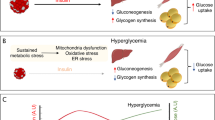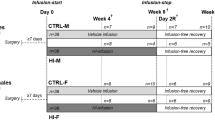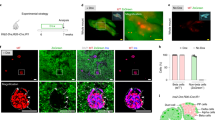Abstract
Noninvasive imaging and quantification of pancreatic, insulin-producing β cells has been considered a high-priority field of investigation for the past decade. In the first review on this issue, attention was already paid to various agents for labeling β cells, including 6-125I-D-glucose, 65Zn, 3H-glibenclamide, 3H-mitiglinide, an 125I-labeled mouse monoclonal antibody against β-cell surface ganglioside(s), D-(U-14C)-glucose and 2-deoxy-2-18F-D-glucose to label glycogen accumulated in β cells in response to sustained hyperglycemia, and, last but not least, an analog of D-mannoheptulose. This Review discusses these methods and further contributions. For instance, emphasis is placed on labeling β cells with 11C-dihydrotetrabenazine, which is the most advanced method at present. Attention is also drawn to the latest approaches for noninvasive imaging and functional characterization of pancreatic β cells. None of these procedures is used in clinical practice yet.
Key Points
-
Noninvasive β-cell imaging could be used to complement information gained during provocative tests that assess the insulin secretory response in individuals with or at high risk of diabetes mellitus
-
One of the main difficulties of noninvasive imaging of β cells resides in the fact that these cells represent only about 1% of the total pancreatic mass
-
Available tools include a D-mannoheptulose analog, alloxan, streptozotocin, hypoglycemic sulfonylureas and glinides, β-cell-specific monoclonal antibodies, L-3,4-dihydroxyphenylalanine, peptidomimetic ligands for somatostatin receptors, dihydratetetrabenazine, optical coherence tomography, and diffusion MRI
-
None of these tools is currently used in clinical practice
This is a preview of subscription content, access via your institution
Access options
Subscribe to this journal
Receive 12 print issues and online access
$189.00 per year
only $15.75 per issue
Buy this article
- Purchase on SpringerLink
- Instant access to full article PDF
Prices may be subject to local taxes which are calculated during checkout
Similar content being viewed by others
References
Wild, S., Roglic, G., Green, A., Sicree, R. & King, H. Global prevalence of diabetes. Estimates for the year 2000 and projections for 2030. Diabetes Care 27, 1047–1053 (2004).
Robertson, R. P. Estimation of β-cell mass by metabolic tests. Necessary, but how sufficient? Diabetes 56, 2420–2424 (2007).
Bouwens, L. & Rooman, I. Regulation of pancreatic β-cell mass. Physiol. Rev. 85, 1255–1270 (2005).
Malaisse, W. J. On the track to the β-cell. Diabetologia 44, 393–406 (2001).
Malaisse, W. J. Non-invasive imaging of the endocrine pancreas. Int. J. Mol. Med. 15, 243–246 (2005).
Paty, B. W., Bonner-Weir, S., Laughlin, M. R., McEwan, A. J. & Shapiro, A. M. Toward development of imaging modalities for islet after transplantation: insights from the National Institutes of Health Workshop on β Cell Imaging. Transplantation 77, 1133–1137 (2004).
Souza, F. et al. Current progress in non-invasive imaging of β cell mass of the endocrine pancreas. Curr. Med. Chem. 13, 2761–2773 (2006).
Lin, M. et al. Advances in molecular imaging of pancreatic β cells. Front. Biosci. 13, 4558–4575 (2008).
Saudek, F., Brogren, C. H. & Manohar, S. Imaging the β-cell mass: why and how. Rev. Diabet. Stud. 5, 6–12 (2008).
Holmberg, D. & Ahlgren, U. Imaging the pancreas: from ex vivo to non-invasive technology. Diabetologia 51, 2148–2154 (2008).
Medarova, Z. & Moore, A. Non-invasive detection of transplanted pancreatic islets. Diabetes Obes. Metab. 10 (Suppl. 4), 88–97 (2008).
Malaisse, W. J., Ladrière, L. & Malaisse-Lagae, F. Pancreatic fate of 6-deoxy-6-[125I]iodo-D-glucose: in vivo experiments. Endocrine 13, 95–101 (2000).
Ladrière, L., Malaisse-Lagae, F. & Malaisse, W. J. Pancreatic uptake of 65Zn in control and streptozotocin-injected rats. Med. Sci. Res. 28, 43–44 (2000).
Ladrière, L., Malaisse-Lagae, F. & Malaisse, W. J. Uptake of tritiated glibenclamide by endocrine and exocrine pancreas. Endocrine 13, 133–136 (2000).
Malaisse, W. J. & Malaisse-Lagae, F. Uptake of tritiated mitiglinide by pancreatic pieces and islets. Diabetes Res. 35, 51–59 (2000).
Ladrière, L., Malaisse-Lagae, F., Alejandro, R. & Malaisse, W. J. Pancreatic fate of a 125I-labelled mouse monoclonal antibody directed against pancreatic β-cell surface ganglioside(s) in control and diabetic rats. Cell Biochem. Funct. 19, 107–115 (2001).
Doherty, M. & Malaisse, W. J. Glycogen accumulation in rat pancreatic islets. In vivo experiments. Endocrine 14, 303–309 (2001).
Ladrière, L., Leclercq-Meyer, V. & Malaisse, W. J. Assessment of islet β-cell mass in isolated rat pancreases perfused with D-[3H]mannoheptulose. Am. J. Physiol. Endocrinol. Metab. 281, E298–E303 (2001).
Malaisse, W. J., Courtois, P., Kadiata, M. M. & Sener, A. GLUT2-mediated transport of D-mannoheptulose: a tool for imaging of the endocrine pancreas? Diabetes 49 (Suppl. 1), A418 (2000).
Simon, E. J. & Kraicer, P. F. The blockade of insulin secretion by mannoheptulose. Isr. J. Med. Sci. 2, 785–799 (1966).
Simon, E., Frenkel, G. & Kraicer, P. F. Blockade of insulin secretion by mannoheptulose. Isr. J. Med. Sci. 6, 743–752 (1972).
Lev-Ran, A., Laor, J., Vins, M. & Simon, E. Effect of intravenous infusion of D-mannoheptulose on blood glucose and insulin levels in man. J. Endocrinol. 47, 137–138 (1970).
Paulsen, E. P. Mannoheptulose and insulin inhibition. Ann. NY Acad. Sci. 150, 455–456 (1968).
Otaga, J. N., Kawano, Y., Bevenue, A. & Casaret, J. L. The ketoheptose content of some tropical fruits. J. Agric. Food Chem. 29, 113–115 (1972).
Viktora, J. K., Johnson, B. F., Penhos, J. C., Rosenberg, C. A. & Wolff, F. W. Effect of ingested mannoheptulose in animals and man. Metabolism 18, 87–102 (1969).
Johnson, B., Viktora, J. & Wolff, F. The efficacy of oral mannoheptulose in monkey and man [abstract]. Diabetes 18 (Suppl. 1), 360 (1969).
Garber, A. J. in Internal Medicine 3rd edn Ch. 343 (ed Stein, J. H.) 2273–2278 (Little & Brown, Boston, 1990).
Bergh, B. O. The avocado and human nutrition. 1. Some human health aspects of the avocado. In Proc. 2nd World Avocado Congress, 1991 April 21–26; Orange, CA (Eds Lovatt, C. J. et al.) 25–35 (University of California, Riverside, 1992).
Mohamed-Yasseen, Y. Uncommon uses of avocado. Tropical Fruit News 28, 14 (1994).
Sener, A. et al. D-mannoheptulose uptake and its metabolic and secretory effects in human pancreatic islets. Int. J. Mol. Med. 6, 617–620 (2000).
Ferrer, J., Benito, C. & Gomis, R. Pancreatic islet GLUT2 glucose transporter mRNA and protein expression in humans with and without NIDDM. Diabetes 44, 1369–1374 (1995).
De Vos, A. et al. Human and rat β cells differ in glucose transporter but not in glucokinase gene expression. J. Clin. Invest. 96, 2489–2495 (1995).
Malaisse, W. J., Doherty, M., Ladrière, L. & Malaisse-Lagae, F. Pancreatic uptake of 2-[14C]alloxan. Int. J. Mol. Med. 7, 311–315 (2001).
Ran, C., Pantazopoulos, P., Medarova, Z. & Moore, A. Synthesis and testing of β-cell-specific streptozotocin-derived near-infrared imaging probes. Angew Chem. Int. Ed. Engl. 46, 8998–9001 (2007).
Sweet, I. R., Cook, L., Lernmark, A., Greenbaum, C. J. & Krohn, K. A. Non-invasive imaging of β cell mass: a quantitative analysis. Diabetes Technol. Ther. 6, 625–629 (2004).
Wängler, B. et al. Synthesis and evaluation of (S.)-2-(2-[18F]fluoroethoxy)-4- ([3-methyl-1-(2-piperidin-1-yl-phenyl)-butyl-carbamoyl]-methyl)-benzoic acid ([18F]repaglinide): a promising radioligand for quantification of pancreatic β-cell mass with positron emission tomography (PET). Nucl. Med. Biol. 31, 639–647 (2004).
Moore, A., Bonner-Weir, S. & Weissleder, R. Noninvasive in vivo measurement of β-cell mass in mouse model of diabetes. Diabetes 50, 2231–2236 (2001).
Paty, B. W. et al. β Cell 125I-labeled IC2 antibody is a promising method of measuring intra-hepatically-transplanted islet mass in vivo [abstract 45]. Presented at Imaging the Pancreatic β Cell, 2003 April 21–22, Bethesda, MD.
Otonkoski, T. et al. Noninvasive diagnosis of focal hyperinsulinism of infancy with 18F-DOPA positron emission tomography. Diabetes 55, 13–18 (2006).
Kauhanen, S. et al. 18F-L-dihydroxyphenylalanine (18F-DOPA) positron emission tomography as a tool to localize an insulinoma or β-cell hyperplasia in adult patients. J. Clin. Endocrinol. Metab. 92, 1237–1244 (2007).
Amartey, J. K., Esguerra, C., Al-Jammaz, I., Parhar, R. S. & Al-Otaibi, B. Synthesis and evaluation of radioiodinated substituted β-naphthylalanine as a potential probe for pancreatic β-cells imaging. Appl. Radiat. Isot. 64, 769–777 (2006).
Evgenov, N. V., Medarova, Z., Dai, G., Bonner-Weir, S. & Moore, A. In vivo imaging of islet transplantation. Nat. Med. 12, 144–148 (2006).
Evgenov, N. V. et al. In vivo imaging of immune rejection in transplanted pancreatic islets. Diabetes 55, 2419–2428 (2006).
Evgenov, N. V., Pratt, J., Pantazopoulos. P. & Moore, A. Effects of glucose toxicity and islet purity on in vivo magnetic resonance imaging of transplanted pancreatic islets. Transplantation 85, 1091–1098 (2008).
Koblas, T. et al. Magnetic resonance imaging of intrahepatically transplanted islets using paramagnetic beads. Transplant. Proc. 37, 3493–3495 (2005).
Toso, C. et al. Clinical magnetic resonance imaging of pancreatic islet grafts after iron nanoparticle labeling. Am. J. Transplant. 8, 701–706 (2008).
Medarova, Z. et al. Noninvasive magnetic resonance imaging of microvascular changes in type 1 diabetes. Diabetes 56, 2677–2682 (2007).
Medarova, Z., Bonner-Weir, S., Lipes, M. & Moore, A. Imaging β-cell death with a near-infrared probe. Diabetes 54, 1780–1788 (2005).
Srinivas, M., Morel, P. A., Ernst, L. A., Laidlaw, D. H. & Ahrens, E. T. 19F-MRI for visualization and quantification of cell migration in a diabetes model. Magn. Reson. Med. 58, 725–734 (2007).
Medarova, Z., Tsai, S., Evgenov, N., Santamaria, P. & Moore, A. In vivo imaging of a diabetogenic CD8+ T cell response during type 1 diabetes progression. Magn. Reson. Med. 59, 712–720 (2008).
Maffei, A. et al. Identification of tissue-restricted transcripts in human islets. Endocrinology 145, 4513–4521 (2004).
Simpson, N. R. et al. Visualizing pancreatic β-cell mass with 11C-DTBZ. Nucl. Med. Biol. 33, 855–864 (2006).
Souza, F. et al. Longitudinal non-invasive PET-based β cell mass estimates in a spontaneous diabetes rat model. J. Clin. Invest. 116, 1506–1513 (2006).
Kung M.-P. et al. In vivo imaging of β-cell mass in rats using 18F-FP-(+)-DTBZ: a potential PET ligand for studying diabetes mellitus. J. Nucl. Med. 49, 1171–1176 (2008).
Goland, R. et al. 11C-DTBZ PET imaging of the pancreas in subjects with longstanding type 1 diabetes and healthy controls. J. Nucl. Med. 50, 382–389 (20089).
Harris, P. E. et al. VMAT2 gene expression and function as it applies to imaging β-cell mass. J. Mol. Med. 86, 5–16 (2008).
Raffo, A. et al. Role of vesicular monoamine transporter type 2 in rodent insulin secretion and glucose metabolism revealed by its specific antagonist tetrabenazine. J. Endocrinol. 198, 1–10 (2008).
Saisho, Y. et al. Relationship between pancreatic vesicular monoamine transporter 2 (VMAT2) and insulin expression in human pancreas. J. Mol. Histol. 39, 543–551 (2008).
Nyqvist, D., Köhler, M., Wahlstedt, H. & Berggren, P.-O. Donor islet endothelial cells participate in formation of functional vessels within pancreatic islet grafts. Diabetes 54, 2287–2293 (2005).
Speier, S. et al. Noninvasive high-resolution in vivo imaging of cell biology in the anterior chamber of the mouse eye. Nat. Protoc. 3, 1278–1286 (2008).
Alanentalo, T. et al. Tomographic molecular imaging and 3D quantification within adult mouse organs. Nat. Methods 4, 31–33 (2006).
Le Bihan, D., Urayama, S.-I., Aso, T., Hanakawa, T. & Fukuyama, H. Direct and fast detection of neuronal activation in the human brain with diffusion MRI. Proc. Natl Acad. Sci. USA 103, 8263–8268 (2006).
Le Bihan, D. See the thinking brain: a story about water [French]. Bull. Mem. Acad. R. Med. Belg. 163, 105–121 (2008).
Miley, H. E., Sheader, E. A., Brown, P. D. & Best, L. Glucose-induced swelling in rat pancreatic β-cells. J. Physiol. 504 (Pt 1), 191–196 (1997).
Malaisse, W. J. See the thinking brain: a story about water [French]. Bull. Mem. Acad. R. Med. Belg. 163, 121–122 (2008).
Acknowledgements
The authors wish to thank U. Ahlgren, P. E. Harris and A. Moore for their helpful comments, and E. Hupkens and C. Demesmaeker for secretarial help. The authors' ongoing research on the imaging of GLUT2-positive cells is supported by convention 716627 from Région Wallonne (Belgium).
Author information
Authors and Affiliations
Corresponding author
Ethics declarations
Competing interests
The authors declare no competing financial interests.
Rights and permissions
About this article
Cite this article
Malaisse, W., Louchami, K. & Sener, A. Noninvasive imaging of pancreatic β cells. Nat Rev Endocrinol 5, 394–400 (2009). https://doi.org/10.1038/nrendo.2009.103
Published:
Issue date:
DOI: https://doi.org/10.1038/nrendo.2009.103
This article is cited by
-
Tri-modal In vivo Imaging of Pancreatic Islets Transplanted Subcutaneously in Mice
Molecular Imaging and Biology (2018)
-
Experimental Approaches for High-Resolution In Vivo Imaging of Islet of Langerhans Biology
Current Diabetes Reports (2011)
-
The role of transmembrane protein 27 (TMEM27) in islet physiology and its potential use as a beta cell mass biomarker
Diabetologia (2010)



